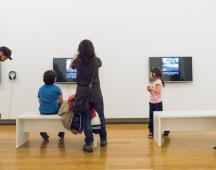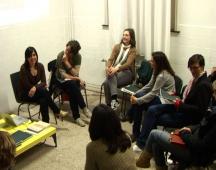O río
- A trama rurubana
The folowing story was built up with the contribution of those who came to the provisional square created
around a scale model_residents, old workers or passers-by who felt like telling their stories. What they said
is based in three main ideas: the river, the land and the factory.
In this account, all their voices talk through the river, joined in a poyphonical voice enacted by me.
A discontinuos place that therefore has connections with the others two stories.
The scale model is part a of a project, NOS CAMIÑOS
audio transcription:
(in the original audio the language is a mix between spanish and galician, exactly as it was recorded during the
two weeks that the instalation took place.
dubbing voice: carme nogueira)
o río. resumo /the river. sumary from carme on Vimeo.
Yes, the jetty… That’s where we used to swim when we were kids, there used to be trout, not lots of them, but, I don’t know, maybe one or two… no, I remember my father bringing home half a dozen for dinner, eh? But then, people come around here because there was nowhere else to go. In the old days, things were really bad, we were so poor. That’s what I was saying to the girl yesterday. I think she understood, but at the same time there was a different sense of togetherness, there were more people here. Now there’s forty thousand of us, and nobody knows each other.
That’s where we learnt to swim in the river Lagares. The name we heard was the river Cambeses, because Cambeses is just down there. Well, it’s not the people’s fault, we live with what we have, what happens is that public areas ought to be better looked after by the authorities.
And we were able to catch trout here, at this curve, and eels too. I used to catch the trout with my hands. Some of us were really good at it, dab hands at it, some of us used to catch the eels. The river was really well known then for how clean it was, with lots of trout, the people from around here used to come and use it as a washing place. But after that, the people couldn’t wash their clothes here any more, because it was… oily, it had the clay they used to make the plates and the mud they used…
Where VANOSA is there was a lake which almost reached Ramón Nieto avenue, there were frogs, different animals. They filled it in. They filled it all in. They filled it in with plates. They filled it in with plates? Yes, with the leftovers.
And it turned out that they started throwing oil into the river. And one day, there were three of us from the association, some youngsters who never went there, and we said, we’re going to show you the river full of oil and stuff and we went to see the waterfalls that are on the right-hand side.
They actually took a part of the river, when the river… and we were sorry to see the animals dying, but we didn’t realise that we couldn’t take up the river’s place, I think it’s like we’re being called to order, about what we do, what we can do, you can see the old photographs and you realise… What a disaster!




















